| URLs in this document have been updated. Links enclosed in {curly brackets} have been changed. If a replacement link was located, the new URL was added and the link is active; if a new site could not be identified, the broken link was removed. |
Science Experiments: Reaching Out to Our Users
Acting Head, Natural Sciences Library and Head, Friday Harbor Library University of Washington Seattle, Washington nolan@u.washington.edu |
Natural Sciences Reference Librarian University of Washington Seattle, Washington loriann@u.washington.edu |
Natural Sciences Information Services Librarian University of Washington Seattle, Washington swright@u.washington.edu |
Director of Education and Outreach Dartmouth College Hanover, New Hampshire laura.barrett@dartmouth.edu |
Map Librarian University of Washington Seattle, Washington parsonsm@u.washington.edu |
Engineering Instructional Services Librarian University of Washington Seattle, Washington lcwhang@u.washington.edu |
Introduction
As more users access library services remotely, it has become increasingly important for librarians to reach out to their user communities and promote the value of libraries. Convincing the faculty and students in the sciences of the value of libraries and librarians can be a particularly "hard sell" as more and more of their primary journal literature becomes available online anywhere from any computer. Six science librarians from the University of Washington experimented with both traditional and unconventional ways to engage our users. We tried meeting them in their spaces, luring them into ours, and using the middle ground of the Internet, with creative initiatives including blogs, give-aways, geocaching, and more.
Background: UW Campus Information
The University of Washington has three campuses -- one in Seattle, one in Bothell (20 miles north of Seattle), and one in Tacoma (38 miles south of Seattle). There are 20 libraries in the UW Libraries system: 16 on the Seattle campus, a branch at the UW Friday Harbor Laboratories in the San Juan Islands, a branch at Harborview Hospital in Seattle, and one at each of the branch campuses.
The seven science libraries on the Seattle campus provide services and resources for 12 science departments in the College of Arts and Sciences, and serve the needs of three science colleges: Oceanography and Fisheries Sciences, Forest Resources, and Engineering. A new College of the Environment is still in the very early planning stages.
The branch science libraries include Chemistry, Engineering, Fisheries-Oceanography, Mathematics, and Physics-Astronomy. The Natural Sciences Library is located within the main Suzzallo and Allen Libraries complex and includes earth and space sciences, atmospheric sciences, biology, botany, zoology, speech and hearing sciences, environmental sciences, history of science and general science. The Map Collection is housed in Suzzallo Library and has an extensive collection of maps, atlases, aerial photographs, and a GIS lab. There are currently 17 science librarians, though they amount to only 14 FTE.
This link to a map of the UW campus shows all of the UW libraries located on the Seattle campus in yellow:
http://www.lib.washington.edu/about/bookdrops.html
User Information
The UW Libraries has been very active in library assessment for over 15 years. Two products of this research, in particular, provide extremely useful insights into the challenges facing UW science librarians when it comes to reaching out to users: the UW Libraries Triennial Survey, a user satisfaction survey distributed every three years, and the Biosciences Task Force Report.
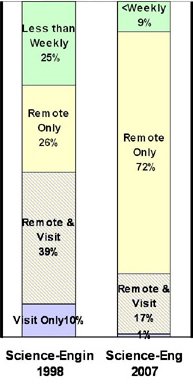
Figure 1: Faculty Mode of Use of UW Libraries
Used with permission of Steve Hiller, Director of Assessment and Planning, University of Washington
Figure 1 identifies results from the 2007 Triennial Survey, showing mode of library use by faculty in the science and engineering departments (not including health sciences). Results are presented for faculty who used Libraries services online or in person, either weekly or more often. The first column shows results from the 1998 Triennial Survey and the second column results from the 2007 survey. In 1998, 10% of sciences and engineering faculty in visited the Libraries in person only, 39% in person and remotely, and 26% remote only. Nine years later, 1% visited in person only, 17% remotely and in person, and 72% remote only. The green boxes on the tops of the columns show that in 1998, 25% of the faculty used the Libraries less than weekly, but in 2007 that dropped to 9%. Survey results found similar trends in library use by graduates and undergraduates. These results may seem disheartening, but the good news is that overall use of the Libraries has actually gone up.
In support of the survey findings, all measures of traditional library use (print use, gate counts, reference statistics, etc.) have declined substantially over the same period of time, while use of remote services have increased dramatically, including more than 4 million downloads of scientific and medical journal articles in 2005 alone.
In October of 2005, the UW Libraries formed a Biosciences Task Force in a concerted effort to better understand the information needs of biosciences users. The Task Force performed an environmental scan, held faculty interviews and focus groups, conducted a peer institution survey and mined data -- including results from the aforementioned Triennial Survey, our In-Library Use Survey (also conducted triennially), and other institutional and library data. The Task Force released its final report in July of 2007. There were three pertinent findings in this report:
- Many bioscientists are not aware of services the UW Libraries provide. In fact, only 40% of biosciences faculty knew enough about our Library Liaison service to rate it.
- Most don't want to come into the physical libraries. They want what they want, in the format they want it, at the moment that they need it.
- Library web sites are not part of our users' normal workflow and, as such, aren't necessarily the most effective means of disseminating information to users.
Based on these results, the UW science librarians realized we needed to experiment with additional ways to reach out to our user communities. Our efforts were of three basic types, going outside of the physical library to meet users in their spaces; luring users back into our spaces; and using the middle ground of the virtual library on the Internet.
Meet Them in Their Spaces
Linda Whang, Engineering Instructional Services Librarian, pioneered meeting her user community directly in their space through the Computer Science and Electrical Engineering "Wireless Librarian" Project. Linda was inspired by the layout of the Paul Allen Center for Computer Science and Engineering building. With its ground floor atrium linking two departments, complete with a coffee cart and small tables for studying, it was a perfect, high-traffic location for providing "embedded reference."
Linda requested and received grant money from the Friends of the Libraries to buy a new sign (Image 2 shows her with the $6 cardboard sign with which she started) and was able to swap her work desktop PC for a laptop. She has a wide variety of people stop by including faculty, graduate and undergraduate students, staff from departments housed in the building as well as visitors, staff and faculty from other departments. Anywhere from zero to five people will stop by during a two-hour period, between two and three people on average. Linda has received reference questions, instruction requests, questions and feedback about databases -- pretty much all the typical questions one would get at the a reference desk.
No matter the user's initial question, Linda asks questions of them about their research or their classes and points them to other resources and library web pages that may be of interest. Finally, as a little reminder of their visit, she provides them with a goodie, usually a vendor-supplied pen item (pen, stapler, notepad, etc.) and a bookmark about the Engineering Library with contact information.
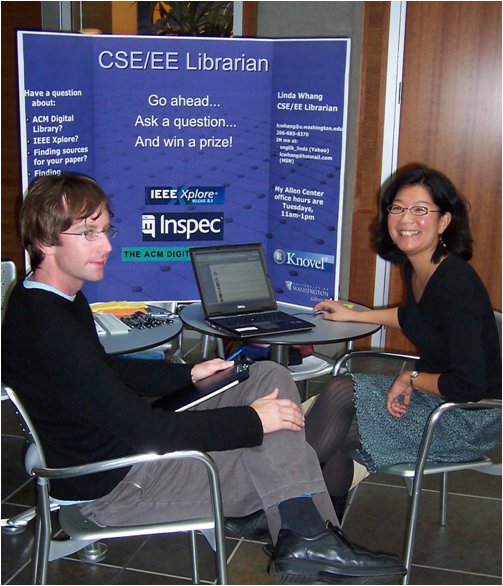
Figure 2: Linda Whang with faculty member
Most of the science librarians also meet with their incoming graduate students for a general orientation to the UW Libraries and provide handouts tailored to specific departments, including new student checklists and customized library resource guides. Several librarians have also created coupons good for a free coffee if students are willing to sit down and meet with us. In addition, we've made increasing use of pre-quarter targeted marketing by sending e-mails to our faculty and graduate students asking if they need orientations, BI sessions, new books, or reserves.
Lure Them into Our Spaces
The next experiment was to try and bring users back into our spaces. We tried the following methods with mixed success.
UW Geocache
Geocaching is an adventure game for GPS (Global Positioning Systems) users. The basic idea is that individuals or organizations hide caches all over the world and share the locations using latitudinal and longitudinal coordinates on the Internet, usually in the form of a puzzle. Players then use the coordinates and their GPS units to locate the caches. A typical cache is a small waterproof container containing a logbook and "treasure," usually toys or trinkets of little value. Geocaching.com is the web site where caches can be registered and shared with other GPS users.
Matthew Parsons, Map Librarian, first got the idea to place a geocache in a UW library from a conference presentation by Linda Musser from the University of Pennsylvania. Matthew enlisted colleagues Maureen Nolan and Stephanie Wright both from the Natural Sciences Library, to design and place the UW Libraries geocache, {House of Stories}. They identified a starting point and determined its latitude and longitude (this had to be an outdoor location); identified interesting waypoints (locations between the starting point and the cache); wrote clues to be solved at each waypoint; and finally registered it with Geocaching.com.
The main objective of the House of Stories geocache is to construct a Library of Congress call number, under which the cache is shelved. The secondary objective was to provide covert library orientation and marketing. For instance, the clues required visiting different units of the library, searching an article database, and ultimately using the Libraries online catalog to conduct an LC call number search to locate the cache.
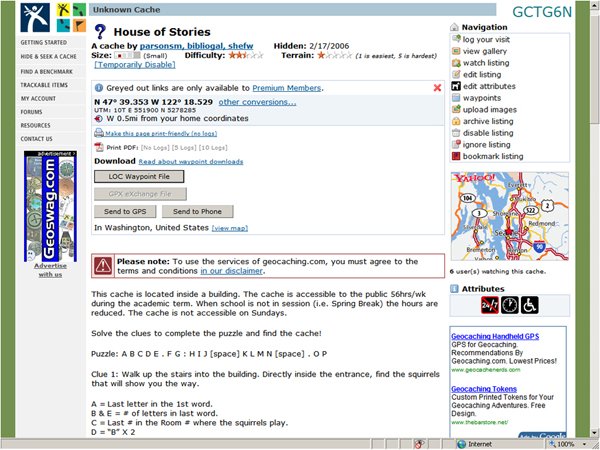
Figure 3: Screen shot of cache on Geocaching.com
The cache log maintained on the web site indicates the cache has lured in people from beyond the University community. To date there have been 105 logged visits for our cache which was placed on February 17, 2006 with the most recent find in October 10, 2008. Other ways of marketing our cache included publishing pieces about it in Library Directions the UW Libraries newsletter, and the ACRL-WA Newsletter.
Topic Table
The Natural Sciences Librarians put up quarterly table displays on topics related to materials in the collection. The display typically consists of a one- or two-sided poster accompanied by a subject-specific sample of books from the unit. A web site related to the display includes an assembled bibliography linking to holdings information in the Libraries catalog.
The topic chosen in Winter Quarter of 2007 was "Global Warming." This particular display included some controversial books on the topic and a poster with opposing viewpoints titled, "Global Warming, Myth or Reality?" with credentialed sources on both sides of the issue. The display generated the most conversation and controversy in recent unit history, and actually inspired students to make and present a poster in response, which we displayed in the library.
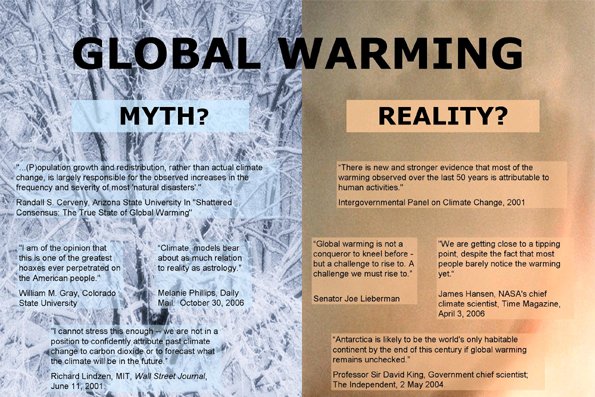
Figure 4: Topic Table poster
Library Scramble (Dawg Daze)
In Fall 2007, four Natural Sciences Librarians took a page from the popularity of "The Amazing Race" TV show and came up with the "Library Scramble" for our annual "Dawg Daze" event. Dawg Daze is geared toward new incoming students and consists of a week of community-building activities at the beginning of every academic year.
Library Scramble used clues and a map of campus to send students to multiple campus libraries. The clues were geared towards the subject areas for each of the libraries visited and the search provided students a chance to become familiar with the layout and terrain of the campus. The first three finishers received a gift certificate to the UW Bookstore. UW Libraries pens, pencils, and temporary tattoos were given to all participants.
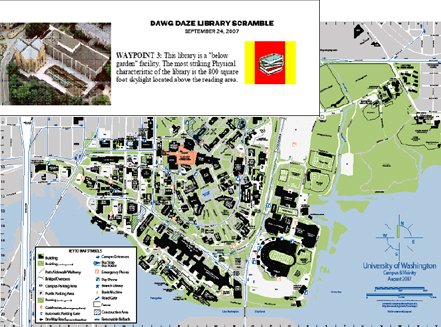
Figure 5: Dawg Daze items
Use the Middle Ground that is the Internet
Collaborative Blog
The Biosciences Report also indicated that the Libraries' web sites were not being used because they weren't part of their normal workflow. Rather than give up on using web sites to disseminate information, why not attempt to make them part of the workflow?
In late 2006, three librarians were lamenting the ineffectiveness in, and sometimes lack of support for, sending e-mails to departments with Libraries news, events, and announcements. As a result of that discussion, a blog was born: LibSphere. It contains UW Libraries information for earth and space, environmental, and atmospheric sciences. Each entry is signed with the name of the librarian who posted it. Each entry is also "tagged" with one or more category labels for easy filtering of posts related to the user's topic of interest by clicking on the appropriate category label in the left-hand menu bar. For example, an earth and space sciences user can personalize the blog by limiting the posts presented to just those tagged with the earth and space sciences label. This is not only more efficient for users but keeps librarians from sending the same e-mail to each of their departments. All the information is in one central location. Users can also leave feedback or comments on blog posts via the comments link. So far, this feature has been little used and users appear to prefer direct e-mail when they have comments.
Blogger, a free web-based blog service provided by Google, allows the use of predesigned blog templates. By using Blogger, we had the blog up and running within half an hour. Blogger also makes it easy to create an RSS feed for the blog so users don't have to visit the web site to see if it's been updated. Posts to LibSphere get incorporated into whatever RSS aggregator library patrons already use. Another benefit of using Blogger is it allows easy use of Google Analytics, another Google web-based service that provides in-depth statistics on how the blog is being used.
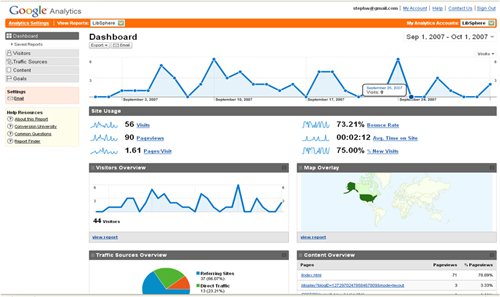
Figure 6: Screen shot of Google Analytics
This screen shot shows the entry page to Google Analytics for the LibSphere blog. From this page it is possible to access more in-depth reports on the number, frequency and timing of visits, whether visits are from new or returning visitors, as well as which and how many pages are visited and length of time of the visit. There is an easily identified spike in visits seen on the graph at the top which corresponds to days when a new post is published. This suggests that patrons are using RSS feeds to read the blog.
Departmental Web Pages
In September of 2005, Laura Barrett, former Undergraduate Services Librarian and Psychology Librarian at the University of Washington, met with the Associate Chair of the Department of Psychology. What started out as a request to add announcements to the departmental web site on occasion, resulted in a {permanent Libraries space} on the site a month later. Laura was given her own pages, the ability to independently post announcements to those pages and the department home page, as well as access to their entire intranet.
Benefits included being able to point people to subject pages based on type of user (faculty, graduate student or undergraduate), more visibility and inclusiveness within the department, and an increase in serendipitous access to library information by faculty and students.
Virtual Reading Room
As science journal publishing moved into an online environment, Maureen Nolan, Head of the UW's Friday Harbor Library, like all other science librarians canceled the print format of a huge number of journals. In order to ease reluctant users into the more virtual environment, Maureen wanted to create a familiar-feeling web page that could act as a "{virtual reading room}" or display area for electronic journals. This highly visual page shows images of the journal covers and links to the 80+ most commonly used periodical titles at the Friday Harbor Library. The page includes date ranges, an icon indicating whether the journal is still available in print, and links to alert services. The Virtual Reading Room was accepted into ACRL Best Practices Clearinghouse in 2004.
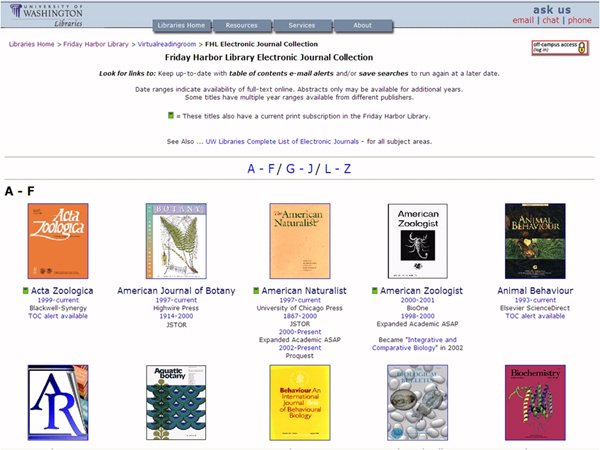
Figure 7: UW Friday Harbor Library Virtual Reading Room
Conclusion
Ideas for Future Outreach
In the time since we've had the opportunity to try all these experiments, we've brainstormed many other outreach ideas. Some we still haven't tried and some need more experimentation to gauge utility.
One area in which we've dabbled and have found to be an easy way to reach out to users is social networking. Over the last few years, UW librarians and staff across multiple branches have started social networking accounts for services such as MySpace, Linked-In, and Facebook in an effort to create another way for users to find us where they are. There has been some hesitation among staff about actively inviting users to our social networking accounts.
Although much of the outreach has been to peers and co-workers, some of us have had wild success engaging with students in this manner. Many of the branch libraries, including the Natural Sciences and Friday Harbor Libraries have Facebook pages with links to library resources. UW's Odegaard Undergraduate Library is considering taking social networking a step further by applying for grant money for banner ads which would be directed toward UW Facebook users.
Another idea with which we've considered but have yet to make progress is podcasting. We're considering a weekly podcast to highlight faculty publications new to the library or new materials on a theme; podcasts to accompany library tours or exhibits; or podcasts of library tutorials.
Tips for Experimenting
Although experimental, all of the outreach methods we've discussed met with some level of success. As many require a minimal input of time and effort, even if they aren't a complete success they're worth a try.
- Align yourself with institutional programs to increase your resource pool.
- Consider doing anything that puts your face in front of your users.
- Mixed results are likely, but there is less to lose than to gain with your efforts. However, be forewarned that some people may not see the value in your experimentation.
- Expect that it may take a long time to see results depending on the situation and try not to become discouraged.
- Brainstorm ideas with all of your co-workers, including the students with whom you work.
- Try something new. Take risks.
- Have fun, that's what experimentation is all about!
For Further Reading:
Albano, J. 2005. The must list: lattes, magnets, and six other ways to connect with your users. College & Research Libraries News, 66(3):203-5, 228.
Arendt, J., and Taylor, M. K. 2006. When the walls crash down: offer services where the students are. College & Research Libraries News, 67(11): 698-700.
Cawthorne, J. E. 2003. Integrating outreach and building partnerships: expanding our role in the learning community. College & Research Libraries News, 64(10): 666-9, 681.
Chesnut, M. T. 2006. The M.A.R.K.E.T approach to promoting your academic library. Kentucky Libraries, 70(4): 8-11.
Coulter, P. and Draper, L. 2006. Blogging it to them: weblogs in information literacy instruction. Journal of Library Administration, 45(1/2): 101-115.
Elder, J. J., Forrest, C., and Thomas, S. 2005. Students are users, too: a research library reaches out to the "undergraduate market" at Emory University. College & Research Libraries News, 66(3): 214-215.
Fabian, C. A., D'Aniello, C., and Tysick, C. 2003. Multiple models for library outreach initiatives. The Reference Librarian, (82): 39-55.
Finlay, H., and Young, D. 2006. Meeting and greeting new students. Library + Information Update, 5(12): 22-23.
Goda, D., Killingsworth, E.K., and Basco, B.B. 2002. University of Central Florida librarians on location. Public Services Quarterly, 1(3): 13-19.
Kwasitsu, L. 2003. Information-seeking behavior of design, process, and manufacturing engineers. Library and Information Science Research, 25: 459-476.
Macaluso, S. J., and Petruzzelli, B. W. 2005. The library liaison toolkit: learning to bridge the communication gap. The Reference Librarian, (89/90): 163-177.
Nelson, M.S. 2007. Initiating engineering outreach reference services: background and practice. Reference Services Review, 35(2): 265-284.
Reed, C. 2005. Reaching out to connect with users: the Jane Bancroft Cook Library experience. Florida Libraries, 47(1): 18-19, 23.
Sutton, L., and Womack, H. D. 2006. Got game? hosting game night in an academic library. College & Research Libraries News, 67(3): 173-176.
Ury, C., and Johnson, C. 2003. Reference beyond the walls of the library: interacting with faculty and students in the 21st century. The Reference Librarian, (83/84): 203-218.
Van Den Broek, R. 2004. Late night at Miller Library: a success story. College & Research Libraries News, 65(10): 576-577.
Vogel, T.M. and Goans, D. 2005. Delivering the news with blogs: the Georgia State University Library experience. Internet Reference Services Quarterly, 10(1): 5-27.
Wagner, A. B., and Tysick, C. 2007. Onsite reference and instruction services: setting up shop where our patrons live. Reference and User Services Quarterly, 46(4): 60-65.
| Previous | Contents | Next |
